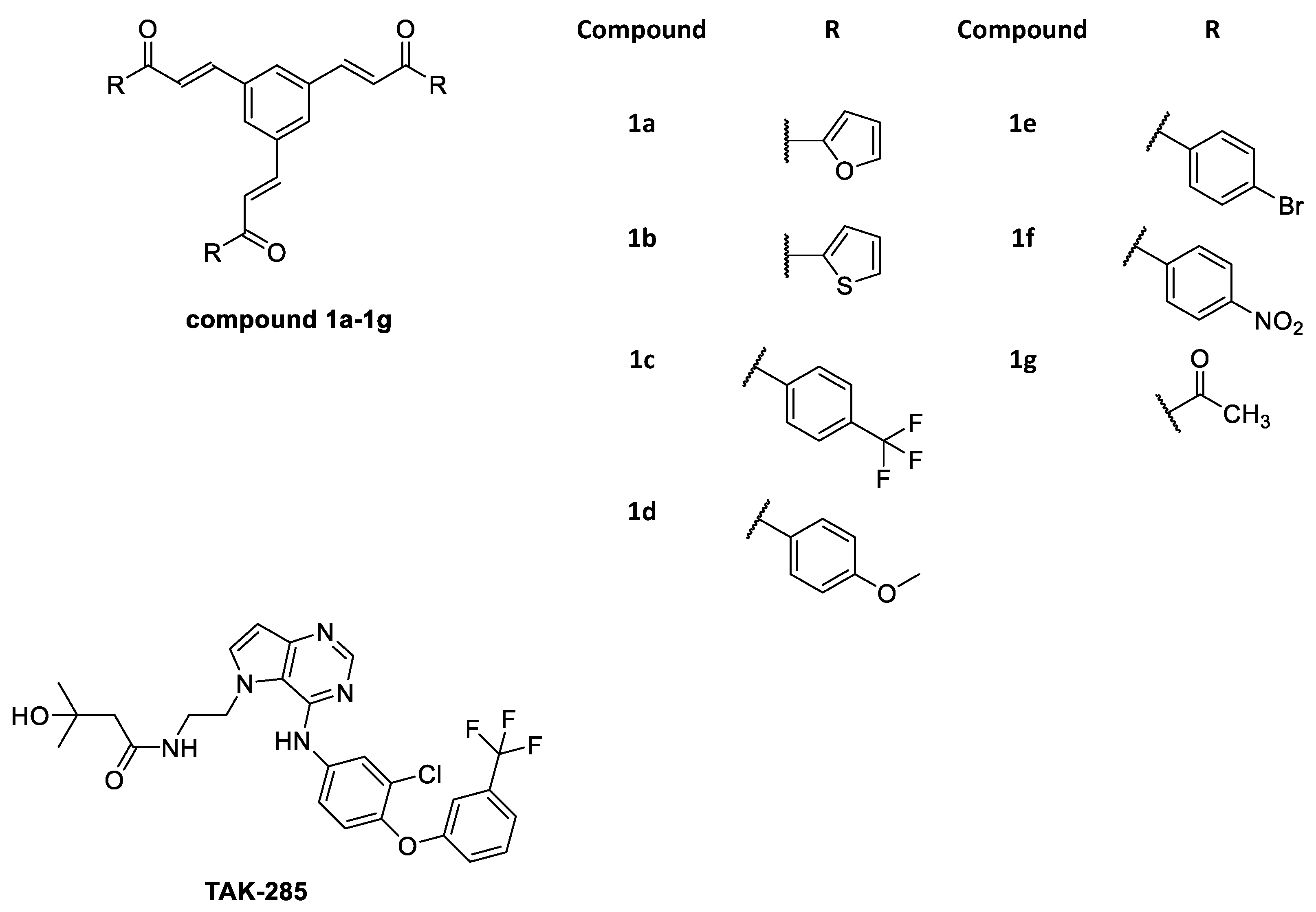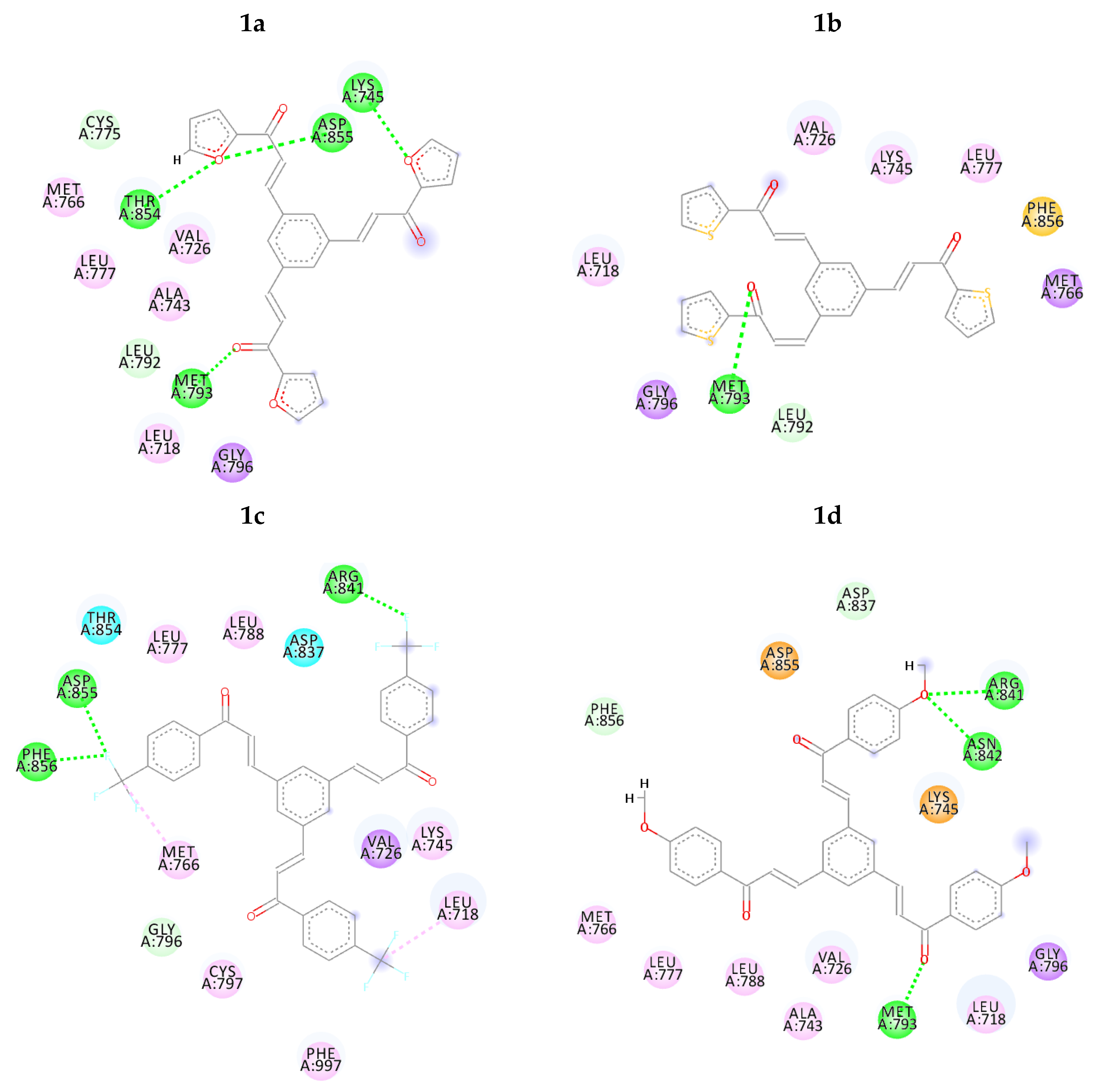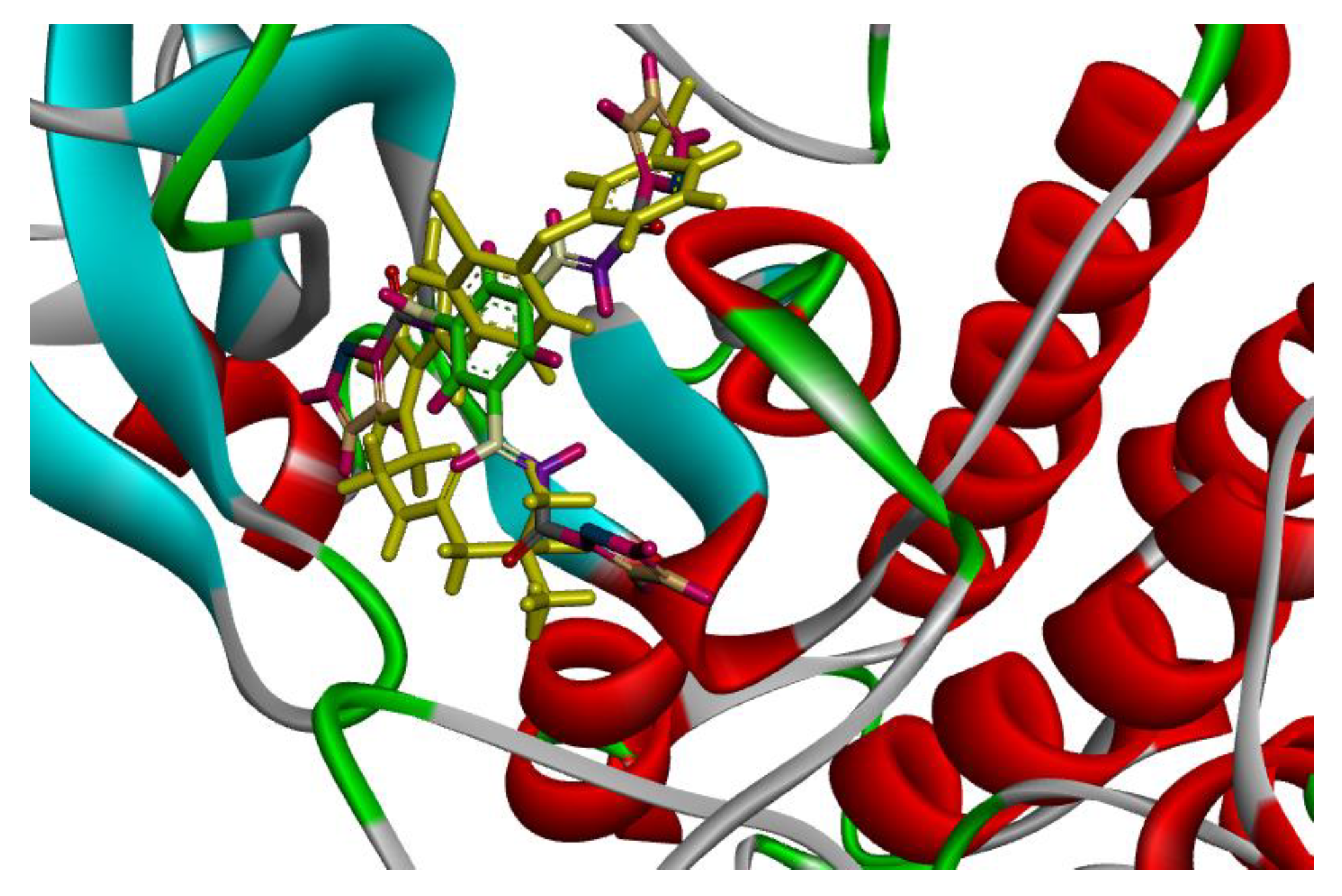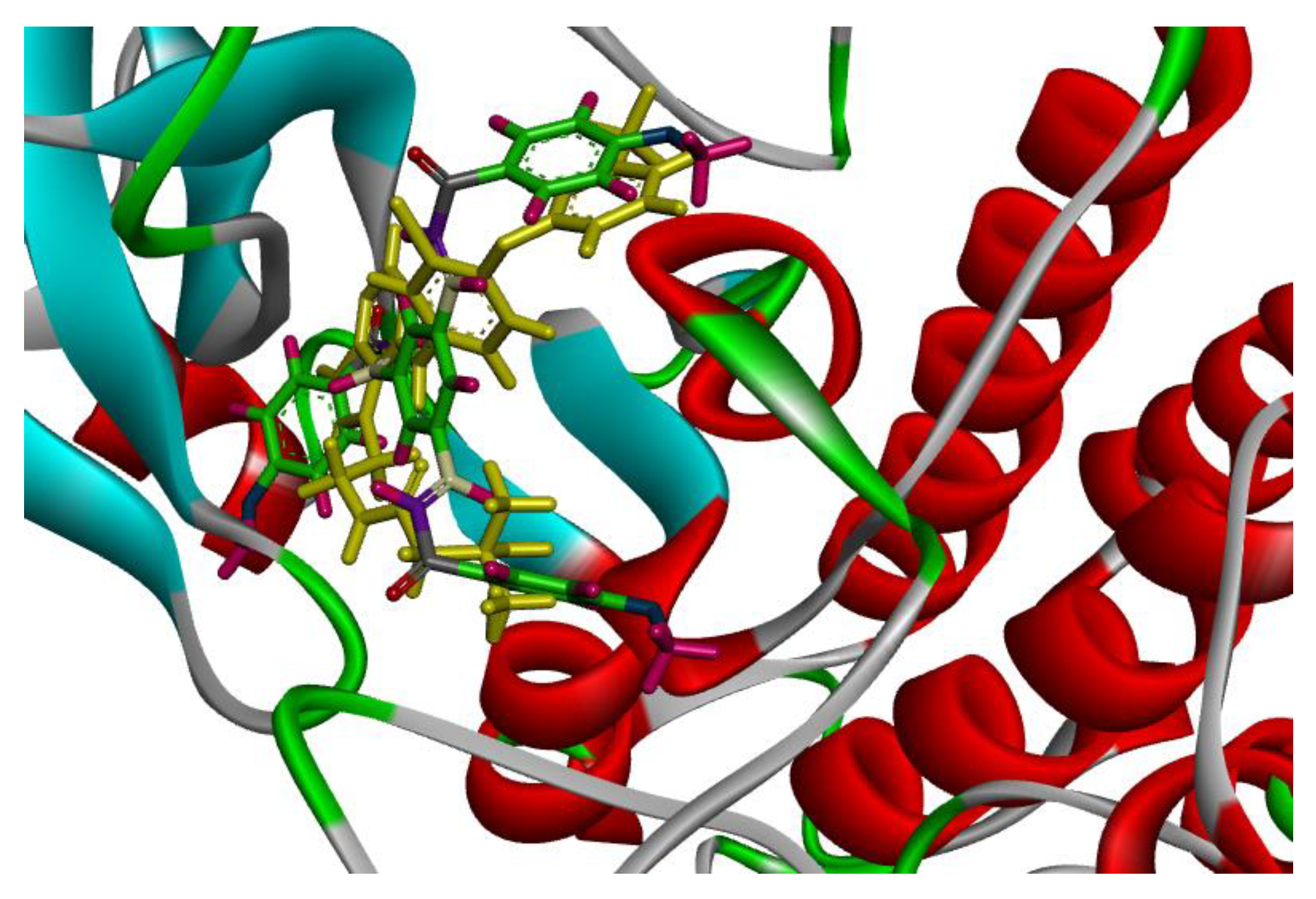Structure-Based Drug Design Studies Toward the Discovery of Novel Chalcone Derivatives as Potential Epidermal Growth Factor Receptor (EGFR) Inhibitors
Abstract
:1. Introduction
2. Materials and Methodology
2.1. Overview
2.2. Software
- a)
- ACD/ChemSketch v. 2016.1.1 (www.acdlabs.com);
- b)
- c)
- AMBER 14 [36].
2.3. Molecular Docking
2.4. Molecular Dynamics
2.4.1. Model Setup
2.4.2. Minimization
2.4.3. Equilibration
2.4.4. Production Stage
2.4.5. MM-GBSA Calculation
3. Results and Discussion
3.1. Molecular Docking
3.2. Molecular Dynamics
3.2.1. Root Mean Square Deviation (RMSD)
3.2.2. Hydrogen Bonding Analysis
3.2.3. Free Energy of Binding Calculation
4. Conclusions
Supplementary Materials
Author Contributions
Funding
Conflicts of Interest
References
- Finlay, M.R.V.; Ward, R.A. Small molecule inhibitors of the epidermal growth factor receptor. In Topics in Medicinal Chemistry; Springer: Berlin, Germany, 2017. [Google Scholar]
- Kaplan, M.; Narasimhan, S.; de Heus, C.; Mance, D.; van Doorn, S.; Houben, K.; Popov-Čeleketić, D.; Damman, R.; Katrukha, E.A.; Jain, P. EGFR dynamics change during activation in native membranes as revealed by NMR. Cell 2016, 167, 1241–1251. [Google Scholar] [CrossRef] [PubMed]
- Harari, P. Epidermal growth factor receptor inhibition strategies in oncology. Endocr. Relat. Cancer 2004, 11, 689–708. [Google Scholar] [CrossRef] [PubMed] [Green Version]
- Harari, P.M.; Huang, S.-M. In Radiation response modification following molecular inhibition of epidermal growth factor receptor signaling. Semin. Radiat. Oncol. 2001, 11, 281–289. [Google Scholar] [CrossRef] [PubMed]
- Herbst, R.S. Review of epidermal growth factor receptor biology. Intern. J. Radiat. Oncol. Biol. Phys. 2004, 59, S21–S26. [Google Scholar] [CrossRef]
- Berasain, C.; Avila, M.A. The EGFR signalling system in the liver: From hepatoprotection to hepatocarcinogenesis. J. Gastroenterol. 2014, 49, 9–23. [Google Scholar] [CrossRef] [PubMed]
- Camp, E.R.; Summy, J.; Bauer, T.W.; Liu, W.; Gallick, G.E.; Ellis, L.M. Molecular mechanisms of resistance to therapies targeting the epidermal growth factor receptor. Clin. Cancer Res. 2005, 11, 397–405. [Google Scholar]
- Choowongkomon, K.; Sawatdichaikul, O.; Songtawee, N.; Limtrakul, J. Receptor-based virtual screening of EGFR kinase inhibitors from the NCI diversity database. Molecules 2010, 15, 4041–4054. [Google Scholar] [CrossRef]
- Gridelli, C.; Bareschino, M.A.; Schettino, C.; Rossi, A.; Maione, P.; Ciardiello, F. Erlotinib in non-small cell lung cancer treatment: Current status and future development. Oncologist 2007, 12, 840–849. [Google Scholar] [CrossRef]
- Irmer, D.; Funk, J.; Blaukat, A. EGFR kinase domain mutations—Functional impact and relevance for lung cancer therapy. Oncogene 2007, 26, 5693. [Google Scholar] [CrossRef]
- Zwick, E.; Bange, J.; Ullrich, A. Receptor tyrosine kinase signalling as a target for cancer intervention strategies. Endocr. Relat. Cancer 2001, 8, 161–173. [Google Scholar] [CrossRef] [Green Version]
- Mitsudomi, T.; Yatabe, Y. Epidermal growth factor receptor in relation to tumor development: EGFR gene and cancer. FEBS 2010, 277, 301–308. [Google Scholar] [CrossRef] [PubMed]
- Al-Suwaidan, I.A.; Abdel-Aziz, A.A.-M.; Shawer, T.Z.; Ayyad, R.R.; Alanazi, A.M.; El-Morsy, A.M.; Mohamed, M.A.; Abdel-Aziz, N.I.; El-Sayed, M.A.-A.; El-Azab, A.S. Synthesis, antitumor activity and molecular docking study of some novel 3-benzyl-4 (3H) quinazolinone analogues. J. Enzyme Inhib. Med. Chem. 2016, 31, 78–89. [Google Scholar] [CrossRef] [PubMed]
- Ahmad, I. An insight into the therapeutic potential of quinazoline derivatives as anticancer agents. MedChemComm 2017, 8, 871–885. [Google Scholar]
- Pao, W.; Miller, V.; Zakowski, M.; Doherty, J.; Politi, K.; Sarkaria, I.; Singh, B.; Heelan, R.; Rusch, V.; Fulton, L. EGF receptor gene mutations are common in lung cancers from “never smokers” and are associated with sensitivity of tumors to gefitinib and erlotinib. Proc. Natl. Acad. Sci. USA 2004, 101, 13306–13311. [Google Scholar] [CrossRef] [PubMed]
- Rosell, R.; Carcereny, E.; Gervais, R.; Vergnenegre, A.; Massuti, B.; Felip, E.; Palmero, R.; Garcia-Gomez, R.; Pallares, C.; Sanchez, J.M. Erlotinib versus standard chemotherapy as first-line treatment for European patients with advanced EGFR mutation-positive non-small-cell lung cancer (EURTAC): A multicentre, open-label, randomised phase 3 trial. Lancet Oncol. 2012, 13, 239–246. [Google Scholar] [CrossRef]
- Udupa, K.; Rajendranath, R.; Sagar, T.; Thomas, J. Differential Toxicities of Tyrosine Kinase Inhibitors in the Management of Metastatic Lung Cancer. Indian J. Med. Paediatr. Oncol. 2017, 38, 15–17. [Google Scholar] [CrossRef] [PubMed]
- Jorge, S.; Kobayashi, S.; Costa, D. Epidermal growth factor receptor (EGFR) mutations in lung cancer: Preclinical and clinical data. Braz. J. Med. Biol. Res. 2014, 47, 929–939. [Google Scholar] [CrossRef]
- Wang, Y.; Schmid-Bindert, G.; Zhou, C. Erlotinib in the treatment of advanced non-small cell lung cancer: An update for clinicians. Ther. Adv. Med Oncol. 2012, 4, 19–29. [Google Scholar] [CrossRef]
- Faraj, F.L.; Zahedifard, M.; Paydar, M.; Looi, C.Y.; Abdul Majid, N.; Ali, H.M.; Ahmad, N.; Gwaram, N.S.; Abdulla, M.A. Synthesis, characterization, and anticancer activity of new quinazoline derivatives against MCF-7 cells. Sci. World J. 2014, 2014. [Google Scholar] [CrossRef]
- Madke, B.; Gole, P.; Kumar, P.; Khopkar, U. Dermatological side effects of epidermal growth factor receptor inhibitors: ‘PRIDE’complex. Indian J. Dermatol. 2014, 59, 271. [Google Scholar] [CrossRef]
- De Carvalho Tavares, L.; Johann, S.; de Almeida Alves, T.M.; Guerra, J.C.; de Souza-Fagundes, E.M.; Cisalpino, P.S.; Bortoluzzi, A.J.; Caramori, G.F.; de Mattos Piccoli, R.; Braibante, H.T. Quinolinyl and quinolinyl N-oxide chalcones: Synthesis, antifungal and cytotoxic activities. Eur. J. Med. Chem. 2011, 46, 4448–4456. [Google Scholar] [CrossRef] [PubMed]
- Wani, Z.A.; Pathania, A.S.; Mahajan, G.; Behl, A.; Mintoo, M.J.; Guru, S.K.; Viswanath, A.; Malik, F.; Kamal, A.; Mondhe, D.M. Anticancer activity of a novel quinazolinone-chalcone derivative through cell cycle arrest in pancreatic cancer cell line. J. Solid Tumors 2015, 5, 73. [Google Scholar] [CrossRef]
- Coşkun, D.; Tekin, S.; Sandal, S.; Coşkun, M.F. Synthesis, characterization, and anticancer activity of new benzofuran substituted chalcones. J. Chem. 2016, 2016. [Google Scholar] [CrossRef]
- Sinha, N.K.; Asnani, A.J.; Dravyakar, B.R. A novel approach towards development of quinazoline derivatives in pain management. Asian J. Pharm. Clin. Res. 2013, 6, 200–204. [Google Scholar]
- Gaonkar, S.L.; Vignesh, U.N. Synthesis and pharmacological properties of chalcones: A review. Res. Chem. Intermed. 2017, 34, 6043–6077. [Google Scholar] [CrossRef]
- Verma, S.; Srivastava, A.; Pandey, O.P. A Review on Chalcones Synthesis and their Biological Activity. Pharma Tutor J. 2018, 6, 22–39. [Google Scholar] [CrossRef]
- Singh, P.; Anand, A.; Kumar, V. Recent developments in biological activities of chalcones: A mini review. Eur. J. Med. Chem. 2014, 85, 758–777. [Google Scholar] [CrossRef] [PubMed]
- Rao, C.M.M.P.; Yejella, R.P.; Rehman, R.S.A.; Basha, S.H. Molecular docking based screening of novel designed chalcone series of compounds for their anti-cancer activity targeting EGFR kinase domain. Bioinformation 2015, 11, 322. [Google Scholar] [CrossRef]
- Alswah, M.; Bayoumi, A.H.; Elgamal, K.; Elmorsy, A.; Ihmaid, S.; Ahmed, H.E. Design, synthesis and cytotoxic evaluation of novel chalcone derivatives bearing triazolo [4,3-a]-quinoxaline moieties as potent anticancer agents with dual EGFR kinase and tubulin polymerization inhibitory effects. Molecules 2017, 23, 48. [Google Scholar] [CrossRef]
- Bagul, C.; Rao, G.K.; Makani, V.K.K.; Tamboli, J.R.; Pal-Bhadra, M.; Kamal, A. Synthesis and biological evaluation of chalcone-linked pyrazolo [1,5-a] pyrimidines as potential anticancer agents. MedChemComm 2017, 8, 1810–1816. [Google Scholar] [CrossRef]
- Al-Najjar, B.O. Synthesis, Molecular Docking and Antioxidant Evaluation of Benzylidene Ketone Derivatives. Jordan J. Biol. Sci. 2018, 11, 307–313. [Google Scholar]
- Al-Najjar, B.O.; Shakya, A.K.; Saqallah, F.G.; Said, R. Pharmacophore modeling and 3D-QSAR studies of 15-hydroxyprostaglandin dehydrogenase (15-PGDH) inhibitors. Indian J. Chem. 2017, 56B, 1200–1206. [Google Scholar]
- Al-Najjar, B.O. Investigation of 15-hydroxyprostaglandin dehydrogenase catalytic reaction mechanism by molecular dynamics simulations. J. Mol. Graph. Model. 2018, 80, 190–196. [Google Scholar] [CrossRef] [PubMed]
- Aertgeerts, K.; Skene, R.; Yano, J.; Sang, B.-C.; Zou, H.; Snell, G.; Jennings, A.; Iwamoto, K.; Habuka, N.; Hirokawa, A. Structural analysis of the mechanism of inhibition and allosteric activation of the kinase domain of HER2 protein. J. Biol. Chem. 2011, 286, 18756–18765. [Google Scholar] [CrossRef] [PubMed]
- Case, D.A.; Babin, V.; Berryman, J.; Betz, R.; Cai, Q.; Cerutti, D.; Cheatham Iii, T.; Darden, T.; Duke, R.; Gohlke, H. Amber 14. Available online: http://ambermd.org/doc12/Amber14.pdf (accessed on 2 November 2018).
- Morris, G.M.; Goodsell, D.S.; Halliday, R.S.; Huey, R.; Hart, W.E.; Belew, R.K.; Olson, A.J. Automated docking using a Lamarckian genetic algorithm and an empirical binding free energy function. J. Comput. Chem. 1998, 19, 1639–1662. [Google Scholar] [CrossRef] [Green Version]
- Morris, G.M.; Huey, R.; Lindstrom, W.; Sanner, M.F.; Belew, R.K.; Goodsell, D.S.; Olson, A.J. AutoDock4 and AutoDockTools4: Automated docking with selective receptor flexibility. J. Comput. Chem. 2009, 30, 2785–2791. [Google Scholar] [CrossRef] [PubMed] [Green Version]
- Maier, J.A.; Martinez, C.; Kasavajhala, K.; Wickstrom, L.; Hauser, K.E.; Simmerling, C. ff14SB: Improving the accuracy of protein side chain and backbone parameters from ff99SB. J. Chem. Theor. Comput. 2015, 11, 3696–3713. [Google Scholar] [CrossRef]
- Wang, J.; Wolf, R.M.; Caldwell, J.W.; Kollman, P.A.; Case, D.A. Development and testing of a general amber force field. J. Comput. Chem. 2004, 25, 1157–1174. [Google Scholar] [CrossRef] [Green Version]
- Ibragimova, G.T.; Wade, R.C. Importance of explicit salt ions for protein stability in molecular dynamics simulation. Biophys. J. 1998, 74, 2906–2911. [Google Scholar] [CrossRef]
- Jorgensen, W.L.; Chandrasekhar, J.; Madura, J.D.; Impey, R.W.; Klein, M.L. Comparison of simple potential functions for simulating liquid water. J. Chem. Phys. 1983, 79, 926–935. [Google Scholar] [CrossRef]
- Berendsen, H.J.; Postma, J.V.; van Gunsteren, W.F.; DiNola, A.; Haak, J. Molecular dynamics with coupling to an external bath. J. Chem. Phys. 1984, 81, 3684–3690. [Google Scholar] [CrossRef]
- Pastor, R.W.; Brooks, B.R.; Szabo, A. An analysis of the accuracy of Langevin and molecular dynamics algorithms. Mol. Phys. 1988, 65, 1409–1419. [Google Scholar] [CrossRef]
- Sousa, S.F.; Fernandes, P.A.; Ramos, M.J. Protein-ligand docking: Current status and future challenges. Proteins Struct. Funct. Bioinform. 2006, 65, 15–26. [Google Scholar] [CrossRef] [PubMed]
- Hatti, K.S.; Chandregowda, V.; Rao, G.V.; Kush, A.; Reddy, G.C. In-silico interaction studies of quinazoline derivatives for their inhibitory action on both wild and mutant EGFRs. J. Proteom. Bioinform. 2009, 2, 126–130. [Google Scholar] [CrossRef]
- Mahajanakatti, A.B.; Murthy, G.; Sharma, N.; Skariyachan, S. Exploring inhibitory potential of Curcumin against various cancer targets by in silico virtual screening. Interdiscip. Sci. Comput. Life Sci. 2014, 6, 13–24. [Google Scholar] [CrossRef] [PubMed]
- Kovacic, P.; Somanathan, R. Nitroaromatic compounds: Environmental toxicity, carcinogenicity, mutagenicity, therapy and mechanism. J. Appl. Toxic. 2014, 34, 810–824. [Google Scholar] [CrossRef]
- Subrahmanyam, R.S.; Ramesh, P.; Krishna, B.S.; Swaroop, S.; Khan, M.A.; Darla, M.M.; K, A.; Bhaskar, B.V.; Rajendra, W.; Anna, V.R. Synthesis and biological evaluation of some new class of chromenoimidazole derivatives as probable anti cancer agents. Positions 2017, 10, 1194–1212. [Google Scholar]
- Chou, K.-C. Structural bioinformatics and its impact to biomedical science and drug discovery. In Frontiers in Medicinal Chemistry; Bentham Science Publishers: Hilversum, The Netherlands, 2006; Volume 3, pp. 455–502. [Google Scholar]
- Wodak, S.J.; Van Belle, D.; Prévost, M. Molecular dynamics and free energy calculations applied to the enzyme barnase and one of its stability mutants. Comput. Model. Mol. Biol. 1995, 61–102. [Google Scholar] [CrossRef]
- Sugunakala, S.; Selvaraj, S. Identification of potential inhibitors of epidermal growth factor receptor tyrosine kinase by virtual screening and docking studies. Int. J. Pharm. Sci. Res. 2017, 8, 1264–1274. [Google Scholar]
- Rastelli, G.; Rio, A.D.; Degliesposti, G.; Sgobba, M. Fast and accurate predictions of binding free energies using MM-PBSA and MM-GBSA. J. Comput. Chem. 2010, 31, 797–810. [Google Scholar] [CrossRef]
Sample Availability: Samples of the compounds are not available from the authors. |








| Compounds | Lowest Binding Energy (kcal/mol) | Interacting Amino Acids |
|---|---|---|
| TAK-285 | −5.85 | MET 93, ARG 41, ASN 42, LYS 45, LEU88, CYS 75 |
| 1a | −8.49 | MET 93, LYS 45, ASP 55, THR 54 |
| 1b | −8.82 | MET 93 |
| 1c | −7.13 | ARG 41, ASP 55, PHE 56, MET 66, LEU 18 |
| 1d | −8.63 | MET 93, ARG 41, ASN 42 |
| 1e | −8.68 | MET 93, LYS 45, MET 66, LEU 18 |
| 1f | −9.36 | MET 93, ARG 41, ASN 42, ASP 55, PHE 56, CYS 97 |
| 1g | −5.66 | CYS 75, LYS 45, LYS 52 |
| Inhibitor | H-Bond Acceptor (Atom@res) | DonorH | Donor | Percentage Occupancy (%) | Average Distance (Angstrom) | Average Angle (Degree) |
|---|---|---|---|---|---|---|
| TAK-285 | 03P 318@N | MET 93@H | MET 93@N | 35.2 | 2.9236 | 163.05 |
| 03P 318@O | LYS 45@HZ2 | LYS 45@NZ | 12.67 | 2.8211 | 160.01 | |
| ALA 22@O | 03P 318@H22 | 03P 318@O2 | 10.54 | 2.7619 | 160.63 | |
| SER 20@O | 03P 318@H22 | 03P 318@O2 | 3.89 | 2.808 | 163.49 | |
| 1a | L1A 318@O4 | MET 93@H | MET 93@N | 80.74 | 2.8447 | 161.96 |
| L1A 318@O | LYS 45@HZ2 | LYS 45@NZ | 4.54 | 2.8384 | 153.83 | |
| 1d | L1D 318@O4 | MET 93@H | MET 93@N | 65.43 | 2.8655 | 161.95 |
| L1D 318@O2 | THR 90@HG1 | THR 90@OG1 | 52.83 | 2.7757 | 160.93 | |
| L1D 318@O2 | GLN 91@HE21 | GLN 91@NE2 | 8.69 | 2.8898 | 153.39 |
| Energy Component | TAK-285 | 1a | 1d |
|---|---|---|---|
| VDWAALS | −77.1403 | −60.4638 | −68.1365 |
| EEL | −24.8001 | −20.18 | −25.2256 |
| ΔGgas (vdw + EEL) | −101.9404 | −80.6438 | −93.3621 |
| EGB | 44.935 | 44.9765 | 45.7953 |
| ESURF | −9.173 | −8.3796 | −9.0521 |
| ΔGsolv (EGB +ESURF) | 35.762 | 36.5969 | 36.7432 |
| ΔGMMGBSA (ΔGgas +ΔGsolv) | −66.1784 | −44.0469 | −56.6189 |
© 2018 by the authors. Licensee MDPI, Basel, Switzerland. This article is an open access article distributed under the terms and conditions of the Creative Commons Attribution (CC BY) license (http://creativecommons.org/licenses/by/4.0/).
Share and Cite
Al-Anazi, M.; Al-Najjar, B.O.; Khairuddean, M. Structure-Based Drug Design Studies Toward the Discovery of Novel Chalcone Derivatives as Potential Epidermal Growth Factor Receptor (EGFR) Inhibitors. Molecules 2018, 23, 3203. https://doi.org/10.3390/molecules23123203
Al-Anazi M, Al-Najjar BO, Khairuddean M. Structure-Based Drug Design Studies Toward the Discovery of Novel Chalcone Derivatives as Potential Epidermal Growth Factor Receptor (EGFR) Inhibitors. Molecules. 2018; 23(12):3203. https://doi.org/10.3390/molecules23123203
Chicago/Turabian StyleAl-Anazi, Menier, Belal O. Al-Najjar, and Melati Khairuddean. 2018. "Structure-Based Drug Design Studies Toward the Discovery of Novel Chalcone Derivatives as Potential Epidermal Growth Factor Receptor (EGFR) Inhibitors" Molecules 23, no. 12: 3203. https://doi.org/10.3390/molecules23123203






